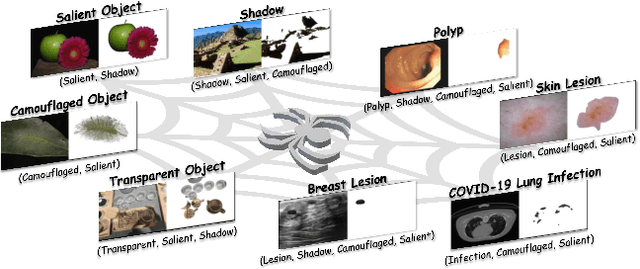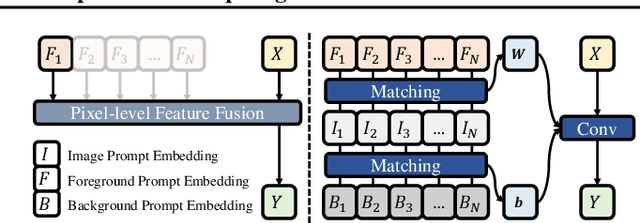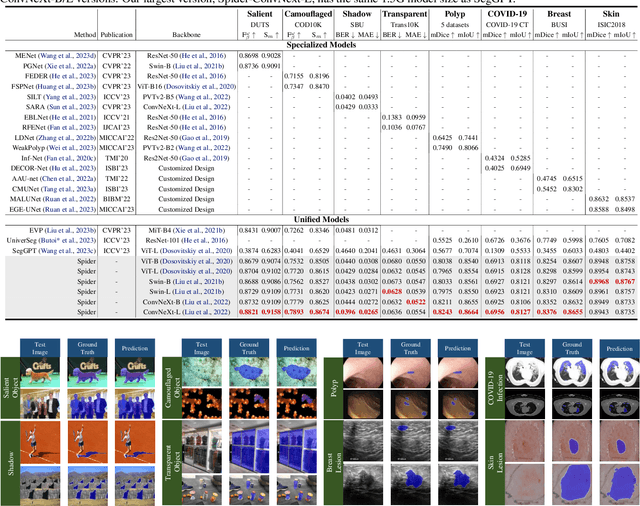Lihe Zhang
EffOWT: Transfer Visual Language Models to Open-World Tracking Efficiently and Effectively
Apr 09, 2025Abstract:Open-World Tracking (OWT) aims to track every object of any category, which requires the model to have strong generalization capabilities. Trackers can improve their generalization ability by leveraging Visual Language Models (VLMs). However, challenges arise with the fine-tuning strategies when VLMs are transferred to OWT: full fine-tuning results in excessive parameter and memory costs, while the zero-shot strategy leads to sub-optimal performance. To solve the problem, EffOWT is proposed for efficiently transferring VLMs to OWT. Specifically, we build a small and independent learnable side network outside the VLM backbone. By freezing the backbone and only executing backpropagation on the side network, the model's efficiency requirements can be met. In addition, EffOWT enhances the side network by proposing a hybrid structure of Transformer and CNN to improve the model's performance in the OWT field. Finally, we implement sparse interactions on the MLP, thus reducing parameter updates and memory costs significantly. Thanks to the proposed methods, EffOWT achieves an absolute gain of 5.5% on the tracking metric OWTA for unknown categories, while only updating 1.3% of the parameters compared to full fine-tuning, with a 36.4% memory saving. Other metrics also demonstrate obvious improvement.
AdvAnchor: Enhancing Diffusion Model Unlearning with Adversarial Anchors
Dec 28, 2024Abstract:Security concerns surrounding text-to-image diffusion models have driven researchers to unlearn inappropriate concepts through fine-tuning. Recent fine-tuning methods typically align the prediction distributions of unsafe prompts with those of predefined text anchors. However, these techniques exhibit a considerable performance trade-off between eliminating undesirable concepts and preserving other concepts. In this paper, we systematically analyze the impact of diverse text anchors on unlearning performance. Guided by this analysis, we propose AdvAnchor, a novel approach that generates adversarial anchors to alleviate the trade-off issue. These adversarial anchors are crafted to closely resemble the embeddings of undesirable concepts to maintain overall model performance, while selectively excluding defining attributes of these concepts for effective erasure. Extensive experiments demonstrate that AdvAnchor outperforms state-of-the-art methods. Our code is publicly available at https://anonymous.4open.science/r/AdvAnchor.
Inspiring the Next Generation of Segment Anything Models: Comprehensively Evaluate SAM and SAM 2 with Diverse Prompts Towards Context-Dependent Concepts under Different Scenes
Dec 02, 2024Abstract:As a foundational model, SAM has significantly influenced multiple fields within computer vision, and its upgraded version, SAM 2, enhances capabilities in video segmentation, poised to make a substantial impact once again. While SAMs (SAM and SAM 2) have demonstrated excellent performance in segmenting context-independent concepts like people, cars, and roads, they overlook more challenging context-dependent (CD) concepts, such as visual saliency, camouflage, product defects, and medical lesions. CD concepts rely heavily on global and local contextual information, making them susceptible to shifts in different contexts, which requires strong discriminative capabilities from the model. The lack of comprehensive evaluation of SAMs limits understanding of their performance boundaries, which may hinder the design of future models. In this paper, we conduct a thorough quantitative evaluation of SAMs on 11 CD concepts across 2D and 3D images and videos in various visual modalities within natural, medical, and industrial scenes. We develop a unified evaluation framework for SAM and SAM 2 that supports manual, automatic, and intermediate self-prompting, aided by our specific prompt generation and interaction strategies. We further explore the potential of SAM 2 for in-context learning and introduce prompt robustness testing to simulate real-world imperfect prompts. Finally, we analyze the benefits and limitations of SAMs in understanding CD concepts and discuss their future development in segmentation tasks. This work aims to provide valuable insights to guide future research in both context-independent and context-dependent concepts segmentation, potentially informing the development of the next version - SAM 3.
Adversarial Training: A Survey
Oct 19, 2024Abstract:Adversarial training (AT) refers to integrating adversarial examples -- inputs altered with imperceptible perturbations that can significantly impact model predictions -- into the training process. Recent studies have demonstrated the effectiveness of AT in improving the robustness of deep neural networks against diverse adversarial attacks. However, a comprehensive overview of these developments is still missing. This survey addresses this gap by reviewing a broad range of recent and representative studies. Specifically, we first describe the implementation procedures and practical applications of AT, followed by a comprehensive review of AT techniques from three perspectives: data enhancement, network design, and training configurations. Lastly, we discuss common challenges in AT and propose several promising directions for future research.
High-Precision Dichotomous Image Segmentation via Probing Diffusion Capacity
Oct 14, 2024



Abstract:In the realm of high-resolution (HR), fine-grained image segmentation, the primary challenge is balancing broad contextual awareness with the precision required for detailed object delineation, capturing intricate details and the finest edges of objects. Diffusion models, trained on vast datasets comprising billions of image-text pairs, such as SD V2.1, have revolutionized text-to-image synthesis by delivering exceptional quality, fine detail resolution, and strong contextual awareness, making them an attractive solution for high-resolution image segmentation. To this end, we propose DiffDIS, a diffusion-driven segmentation model that taps into the potential of the pre-trained U-Net within diffusion models, specifically designed for high-resolution, fine-grained object segmentation. By leveraging the robust generalization capabilities and rich, versatile image representation prior of the SD models, coupled with a task-specific stable one-step denoising approach, we significantly reduce the inference time while preserving high-fidelity, detailed generation. Additionally, we introduce an auxiliary edge generation task to not only enhance the preservation of fine details of the object boundaries, but reconcile the probabilistic nature of diffusion with the deterministic demands of segmentation. With these refined strategies in place, DiffDIS serves as a rapid object mask generation model, specifically optimized for generating detailed binary maps at high resolutions, while demonstrating impressive accuracy and swift processing. Experiments on the DIS5K dataset demonstrate the superiority of DiffDIS, achieving state-of-the-art results through a streamlined inference process. Our code will be made publicly available.
High-Performance Few-Shot Segmentation with Foundation Models: An Empirical Study
Sep 10, 2024Abstract:Existing few-shot segmentation (FSS) methods mainly focus on designing novel support-query matching and self-matching mechanisms to exploit implicit knowledge in pre-trained backbones. However, the performance of these methods is often constrained by models pre-trained on classification tasks. The exploration of what types of pre-trained models can provide more beneficial implicit knowledge for FSS remains limited. In this paper, inspired by the representation consistency of foundational computer vision models, we develop a FSS framework based on foundation models. To be specific, we propose a simple approach to extract implicit knowledge from foundation models to construct coarse correspondence and introduce a lightweight decoder to refine coarse correspondence for fine-grained segmentation. We systematically summarize the performance of various foundation models on FSS and discover that the implicit knowledge within some of these models is more beneficial for FSS than models pre-trained on classification tasks. Extensive experiments on two widely used datasets demonstrate the effectiveness of our approach in leveraging the implicit knowledge of foundation models. Notably, the combination of DINOv2 and DFN exceeds previous state-of-the-art methods by 17.5% on COCO-20i. Code is available at https://github.com/DUT-CSJ/FoundationFSS.
Beyond Mask: Rethinking Guidance Types in Few-shot Segmentation
Jul 16, 2024Abstract:Existing few-shot segmentation (FSS) methods mainly focus on prototype feature generation and the query-support matching mechanism. As a crucial prompt for generating prototype features, the pair of image-mask types in the support set has become the default setting. However, various types such as image, text, box, and mask all can provide valuable information regarding the objects in context, class, localization, and shape appearance. Existing work focuses on specific combinations of guidance, leading FSS into different research branches. Rethinking guidance types in FSS is expected to explore the efficient joint representation of the coupling between the support set and query set, giving rise to research trends in the weakly or strongly annotated guidance to meet the customized requirements of practical users. In this work, we provide the generalized FSS with seven guidance paradigms and develop a universal vision-language framework (UniFSS) to integrate prompts from text, mask, box, and image. Leveraging the advantages of large-scale pre-training vision-language models in textual and visual embeddings, UniFSS proposes high-level spatial correction and embedding interactive units to overcome the semantic ambiguity drawbacks typically encountered by pure visual matching methods when facing intra-class appearance diversities. Extensive experiments show that UniFSS significantly outperforms the state-of-the-art methods. Notably, the weakly annotated class-aware box paradigm even surpasses the finely annotated mask paradigm.
Spatial Semantic Recurrent Mining for Referring Image Segmentation
May 15, 2024Abstract:Referring Image Segmentation (RIS) consistently requires language and appearance semantics to more understand each other. The need becomes acute especially under hard situations. To achieve, existing works tend to resort to various trans-representing mechanisms to directly feed forward language semantic along main RGB branch, which however will result in referent distribution weakly-mined in space and non-referent semantic contaminated along channel. In this paper, we propose Spatial Semantic Recurrent Mining (S\textsuperscript{2}RM) to achieve high-quality cross-modality fusion. It follows a working strategy of trilogy: distributing language feature, spatial semantic recurrent coparsing, and parsed-semantic balancing. During fusion, S\textsuperscript{2}RM will first generate a constraint-weak yet distribution-aware language feature, then bundle features of each row and column from rotated features of one modality context to recurrently correlate relevant semantic contained in feature from other modality context, and finally resort to self-distilled weights to weigh on the contributions of different parsed semantics. Via coparsing, S\textsuperscript{2}RM transports information from the near and remote slice layers of generator context to the current slice layer of parsed context, capable of better modeling global relationship bidirectional and structured. Besides, we also propose a Cross-scale Abstract Semantic Guided Decoder (CASG) to emphasize the foreground of the referent, finally integrating different grained features at a comparatively low cost. Extensive experimental results on four current challenging datasets show that our proposed method performs favorably against other state-of-the-art algorithms.
Spider: A Unified Framework for Context-dependent Concept Understanding
May 02, 2024



Abstract:Different from the context-independent (CI) concepts such as human, car, and airplane, context-dependent (CD) concepts require higher visual understanding ability, such as camouflaged object and medical lesion. Despite the rapid advance of many CD understanding tasks in respective branches, the isolated evolution leads to their limited cross-domain generalisation and repetitive technique innovation. Since there is a strong coupling relationship between foreground and background context in CD tasks, existing methods require to train separate models in their focused domains. This restricts their real-world CD concept understanding towards artificial general intelligence (AGI). We propose a unified model with a single set of parameters, Spider, which only needs to be trained once. With the help of the proposed concept filter driven by the image-mask group prompt, Spider is able to understand and distinguish diverse strong context-dependent concepts to accurately capture the Prompter's intention. Without bells and whistles, Spider significantly outperforms the state-of-the-art specialized models in 8 different context-dependent segmentation tasks, including 4 natural scenes (salient, camouflaged, and transparent objects and shadow) and 4 medical lesions (COVID-19, polyp, breast, and skin lesion with color colonoscopy, CT, ultrasound, and dermoscopy modalities). Besides, Spider shows obvious advantages in continuous learning. It can easily complete the training of new tasks by fine-tuning parameters less than 1\% and bring a tolerable performance degradation of less than 5\% for all old tasks. The source code will be publicly available at \href{https://github.com/Xiaoqi-Zhao-DLUT/Spider-UniCDSeg}{Spider-UniCDSeg}.
Multi-view Aggregation Network for Dichotomous Image Segmentation
Apr 11, 2024Abstract:Dichotomous Image Segmentation (DIS) has recently emerged towards high-precision object segmentation from high-resolution natural images. When designing an effective DIS model, the main challenge is how to balance the semantic dispersion of high-resolution targets in the small receptive field and the loss of high-precision details in the large receptive field. Existing methods rely on tedious multiple encoder-decoder streams and stages to gradually complete the global localization and local refinement. Human visual system captures regions of interest by observing them from multiple views. Inspired by it, we model DIS as a multi-view object perception problem and provide a parsimonious multi-view aggregation network (MVANet), which unifies the feature fusion of the distant view and close-up view into a single stream with one encoder-decoder structure. With the help of the proposed multi-view complementary localization and refinement modules, our approach established long-range, profound visual interactions across multiple views, allowing the features of the detailed close-up view to focus on highly slender structures.Experiments on the popular DIS-5K dataset show that our MVANet significantly outperforms state-of-the-art methods in both accuracy and speed. The source code and datasets will be publicly available at \href{https://github.com/qianyu-dlut/MVANet}{MVANet}.
 Add to Chrome
Add to Chrome Add to Firefox
Add to Firefox Add to Edge
Add to Edge